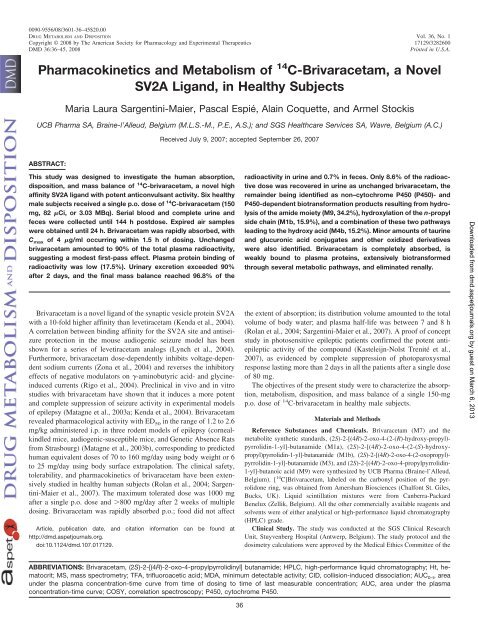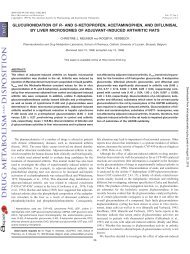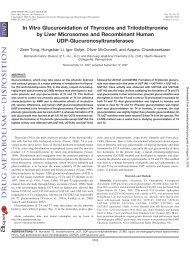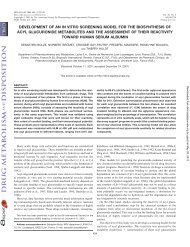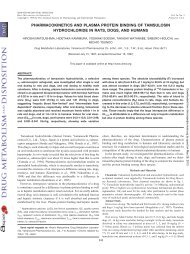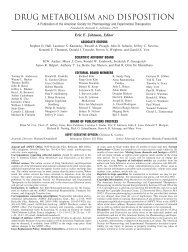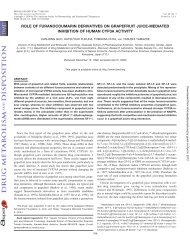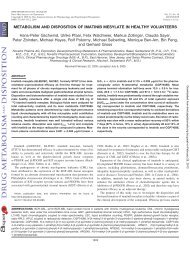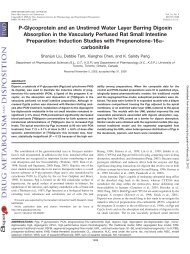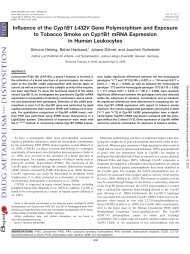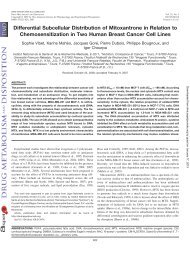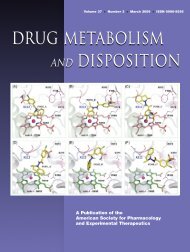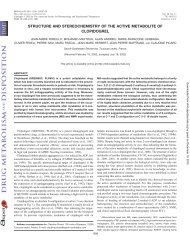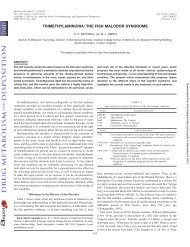Pharmacokinetics and Metabolism of 14C-Brivaracetam, a Novel ...
Pharmacokinetics and Metabolism of 14C-Brivaracetam, a Novel ...
Pharmacokinetics and Metabolism of 14C-Brivaracetam, a Novel ...
Create successful ePaper yourself
Turn your PDF publications into a flip-book with our unique Google optimized e-Paper software.
0090-9556/08/3601-36–45$20.00<br />
DRUG METABOLISM AND DISPOSITION Vol. 36, No. 1<br />
Copyright © 2008 by The American Society for Pharmacology <strong>and</strong> Experimental Therapeutics 17129/3282600<br />
DMD 36:36–45, 2008 Printed in U.S.A.<br />
<strong>Pharmacokinetics</strong> <strong>and</strong> <strong>Metabolism</strong> <strong>of</strong> 14 C-<strong>Brivaracetam</strong>, a <strong>Novel</strong><br />
SV2A Lig<strong>and</strong>, in Healthy Subjects<br />
Maria Laura Sargentini-Maier, Pascal Espié, Alain Coquette, <strong>and</strong> Armel Stockis<br />
UCB Pharma SA, Braine-l’Alleud, Belgium (M.L.S.-M., P.E., A.S.); <strong>and</strong> SGS Healthcare Services SA, Wavre, Belgium (A.C.)<br />
ABSTRACT:<br />
This study was designed to investigate the human absorption,<br />
disposition, <strong>and</strong> mass balance <strong>of</strong> 14 C-brivaracetam, a novel high<br />
affinity SV2A lig<strong>and</strong> with potent anticonvulsant activity. Six healthy<br />
male subjects received a single p.o. dose <strong>of</strong> 14 C-brivaracetam (150<br />
mg, 82 Ci, or 3.03 MBq). Serial blood <strong>and</strong> complete urine <strong>and</strong><br />
feces were collected until 144 h postdose. Expired air samples<br />
were obtained until 24 h. <strong>Brivaracetam</strong> was rapidly absorbed, with<br />
C max <strong>of</strong> 4 g/ml occurring within 1.5 h <strong>of</strong> dosing. Unchanged<br />
brivaracetam amounted to 90% <strong>of</strong> the total plasma radioactivity,<br />
suggesting a modest first-pass effect. Plasma protein binding <strong>of</strong><br />
radioactivity was low (17.5%). Urinary excretion exceeded 90%<br />
after 2 days, <strong>and</strong> the final mass balance reached 96.8% <strong>of</strong> the<br />
<strong>Brivaracetam</strong> is a novel lig<strong>and</strong> <strong>of</strong> the synaptic vesicle protein SV2A<br />
with a 10-fold higher affinity than levetiracetam (Kenda et al., 2004).<br />
A correlation between binding affinity for the SV2A site <strong>and</strong> antiseizure<br />
protection in the mouse audiogenic seizure model has been<br />
shown for a series <strong>of</strong> levetiracetam analogs (Lynch et al., 2004).<br />
Furthermore, brivaracetam dose-dependently inhibits voltage-dependent<br />
sodium currents (Zona et al., 2004) <strong>and</strong> reverses the inhibitory<br />
effects <strong>of</strong> negative modulators on -aminobutyric acid- <strong>and</strong> glycineinduced<br />
currents (Rigo et al., 2004). Preclinical in vivo <strong>and</strong> in vitro<br />
studies with brivaracetam have shown that it induces a more potent<br />
<strong>and</strong> complete suppression <strong>of</strong> seizure activity in experimental models<br />
<strong>of</strong> epilepsy (Matagne et al., 2003a; Kenda et al., 2004). <strong>Brivaracetam</strong><br />
revealed pharmacological activity with ED 50 in the range <strong>of</strong> 1.2 to 2.6<br />
mg/kg administered i.p. in three rodent models <strong>of</strong> epilepsy (cornealkindled<br />
mice, audiogenic-susceptible mice, <strong>and</strong> Genetic Absence Rats<br />
from Strasbourg) (Matagne et al., 2003b), corresponding to predicted<br />
human equivalent doses <strong>of</strong> 70 to 160 mg/day using body weight or 6<br />
to 25 mg/day using body surface extrapolation. The clinical safety,<br />
tolerability, <strong>and</strong> pharmacokinetics <strong>of</strong> brivaracetam have been extensively<br />
studied in healthy human subjects (Rolan et al., 2004; Sargentini-Maier<br />
et al., 2007). The maximum tolerated dose was 1000 mg<br />
after a single p.o. dose <strong>and</strong> 800 mg/day after 2 weeks <strong>of</strong> multiple<br />
dosing. <strong>Brivaracetam</strong> was rapidly absorbed p.o.; food did not affect<br />
Article, publication date, <strong>and</strong> citation information can be found at<br />
http://dmd.aspetjournals.org.<br />
doi:10.1124/dmd.107.017129.<br />
Received July 9, 2007; accepted September 26, 2007<br />
radioactivity in urine <strong>and</strong> 0.7% in feces. Only 8.6% <strong>of</strong> the radioactive<br />
dose was recovered in urine as unchanged brivaracetam, the<br />
remainder being identified as non–cytochrome P450 (P450)- <strong>and</strong><br />
P450-dependent biotransformation products resulting from hydrolysis<br />
<strong>of</strong> the amide moiety (M9, 34.2%), hydroxylation <strong>of</strong> the n-propyl<br />
side chain (M1b, 15.9%), <strong>and</strong> a combination <strong>of</strong> these two pathways<br />
leading to the hydroxy acid (M4b, 15.2%). Minor amounts <strong>of</strong> taurine<br />
<strong>and</strong> glucuronic acid conjugates <strong>and</strong> other oxidized derivatives<br />
were also identified. <strong>Brivaracetam</strong> is completely absorbed, is<br />
weakly bound to plasma proteins, extensively biotransformed<br />
through several metabolic pathways, <strong>and</strong> eliminated renally.<br />
the extent <strong>of</strong> absorption; its distribution volume amounted to the total<br />
volume <strong>of</strong> body water; <strong>and</strong> plasma half-life was between 7 <strong>and</strong> 8 h<br />
(Rolan et al., 2004; Sargentini-Maier et al., 2007). A pro<strong>of</strong> <strong>of</strong> concept<br />
study in photosensitive epileptic patients confirmed the potent antiepileptic<br />
activity <strong>of</strong> the compound (Kasteleijn-Nolst Trenité et al.,<br />
2007), as evidenced by complete suppression <strong>of</strong> photoparoxysmal<br />
response lasting more than 2 days in all the patients after a single dose<br />
<strong>of</strong> 80 mg.<br />
The objectives <strong>of</strong> the present study were to characterize the absorption,<br />
metabolism, disposition, <strong>and</strong> mass balance <strong>of</strong> a single 150-mg<br />
p.o. dose <strong>of</strong> 14 C-brivaracetam in healthy male subjects.<br />
Materials <strong>and</strong> Methods<br />
Reference Substances <strong>and</strong> Chemicals. <strong>Brivaracetam</strong> (M7) <strong>and</strong> the<br />
metabolite synthetic st<strong>and</strong>ards, (2S)-2-[(4R)-2-oxo-4-(2-(R)-hydroxy-propyl)pyrrolidin-1-yl]-butanamide<br />
(M1a), (2S)-2-[(4R)-2-oxo-4-(2-(S)-hydroxypropyl)pyrrolidin-1-yl]-butanamide<br />
(M1b), (2S)-2-[(4R)-2-oxo-4-(2-oxopropyl)pyrrolidin-1-yl]-butanamide<br />
(M3), <strong>and</strong> (2S)-2-[(4R)-2-oxo-4-propylpyrrolidin-<br />
1-yl]-butanoic acid (M9) were synthesized by UCB Pharma (Braine-l’Alleud,<br />
Belgium). [ 14 C]<strong>Brivaracetam</strong>, labeled on the carbonyl position <strong>of</strong> the pyrrolidone<br />
ring, was obtained from Amersham Biosciences (Chalfont St. Giles,<br />
Bucks, UK). Liquid scintillation mixtures were from Canberra-Packard<br />
Benelux (Zellik, Belgium). All the other commercially available reagents <strong>and</strong><br />
solvents were <strong>of</strong> either analytical or high-performance liquid chromatography<br />
(HPLC) grade.<br />
Clinical Study. The study was conducted at the SGS Clinical Research<br />
Unit, Stuyvenberg Hospital (Antwerp, Belgium). The study protocol <strong>and</strong> the<br />
dosimetry calculations were approved by the Medical Ethics Committee <strong>of</strong> the<br />
ABBREVIATIONS: <strong>Brivaracetam</strong>, (2S)-2-[(4R)-2-oxo-4-propylpyrrolidinyl] butanamide; HPLC, high-performance liquid chromatography; Ht, hematocrit;<br />
MS, mass spectrometry; TFA, trifluoroacetic acid; MDA, minimum detectable activity; CID, collision-induced dissociation; AUC 0-t, area<br />
under the plasma concentration-time curve from time <strong>of</strong> dosing to time <strong>of</strong> last measurable concentration; AUC, area under the plasma<br />
concentration-time curve; COSY, correlation spectroscopy; P450, cytochrome P450.<br />
36<br />
Downloaded from<br />
dmd.aspetjournals.org by guest on March 6, 2013
TABLE 1<br />
Individual <strong>and</strong> mean (S.D.) cumulative excretion <strong>of</strong> 14 C-brivaracetam (% dose)<br />
until 144 h postdose (n 6)<br />
public hospitals <strong>of</strong> the city <strong>of</strong> Antwerp. The trial was conducted according to<br />
the recommendations described in the Declaration <strong>of</strong> Helsinki. Written informed<br />
consent was obtained from each subject before the start <strong>of</strong> the trial,<br />
after being informed <strong>of</strong> the nature <strong>and</strong> implications <strong>of</strong> the study.<br />
The tissue distribution in nonpigmented <strong>and</strong> pigmented rats allowed the<br />
conclusion that the p.o. administration <strong>of</strong> 2.9 MBq (79 Ci) <strong>of</strong> 14 Cbrivaracetam<br />
would result in a committed effective dose <strong>of</strong> 0.1 mSv, placing<br />
this trial at the upper limit <strong>of</strong> Risk Category I (ICRP Publication 60, 1991;<br />
ICRP Publication 62, 1993), namely, one tenth <strong>of</strong> the maximum permissible<br />
dose in this type <strong>of</strong> trial (category IIa, 1 mSv). <strong>Brivaracetam</strong> was dissolved in<br />
ethanol together with 14 C-brivaracetam in suitable proportions to obtain a<br />
specific radioactivity <strong>of</strong> approximately 20 KBq/mg (0.54 Ci/mg). The solution<br />
was evaporated to dryness, <strong>and</strong> 150 mg <strong>of</strong> powder was accurately weighed<br />
(to the nearest 0.1 mg) into hard gelatin capsules without excipients. The<br />
amount per capsule, the specific radioactivity <strong>of</strong> the labeled drug substance, the<br />
total radioactivity per capsule, <strong>and</strong> the isotopic purity were controlled shortly<br />
before use.<br />
After an overnight fast, six healthy male subjects took one capsule containing<br />
150 mg <strong>of</strong> 14 C-brivaracetam with 240 ml <strong>of</strong> water. The participants<br />
remained in upright position for 1 h. Food was withheld until 4 h postdose.<br />
St<strong>and</strong>ardized meals were provided according to a fixed schedule. The subjects<br />
remained confined in the unit for the first 8 days <strong>of</strong> the study or until at least<br />
95% <strong>of</strong> the radioactive dose was excreted.<br />
Blood samples were collected in heparin-containing tubes before dosing <strong>and</strong><br />
at 0.25, 0.5, 1, 1.5, 2, 3, 4, 6, 9, 12, 24, 36, 48, 72, 96, 120, <strong>and</strong> 144 h postdose.<br />
For metabolite identification <strong>and</strong> ex vivo radioactivity protein binding measurements,<br />
additional blood samples were collected from each subject at 1, 12,<br />
<strong>and</strong> 24 h postdose. Aliquots <strong>of</strong> 1 ml were kept for the determination <strong>of</strong><br />
% dose excreted in urine<br />
100<br />
80<br />
60<br />
40<br />
20<br />
0<br />
Subject Mean (S.D.)<br />
1 2 3 4 5 6<br />
Urine 97.9 96.6 96.1 96.3 97.6 96.4 96.8 (0.7)<br />
Feces 0.527 0.951 0.571 0.545 0.723 0.928 0.71 (0.19)<br />
Air N.D. N.D. N.D. N.D. N.D. N.D.<br />
Total 98.4 97.6 96.7 96.8 98.3 97.3 97.5 (0.7)<br />
N.D., not detected.<br />
PHARMACOKINETICS AND METABOLISM OF 14 C-BRIVARACETAM<br />
100<br />
80<br />
60<br />
40<br />
20<br />
0<br />
0 6 12 18 24 30 36 42 48<br />
0 24 48 72 96 120 144 168<br />
Time (h)<br />
radioactivity in whole blood, <strong>and</strong> the remainder was centrifuged at 4°C. Plasma<br />
samples were obtained by centrifugation (10 min, 2000g, 4°C) <strong>and</strong> transferred<br />
into polypropylene tubes for the determination <strong>of</strong> total radioactivity, for the<br />
determination <strong>of</strong> the parent compound, <strong>and</strong> for metabolic pr<strong>of</strong>iling. Hematocrit<br />
was determined once daily in the morning. Expired air was collected at predose<br />
<strong>and</strong> 0.5, 1, 1.5, 2, 3, 4, 6, 9, 12, <strong>and</strong> 24 h postdose: subjects were requested to<br />
blow through a glass straw into a vial containing 4 ml <strong>of</strong> a 1:1 mixture <strong>of</strong><br />
Hyamine 10 hydroxide <strong>and</strong> 96% ethanol containing 0.02% phenolphthalein<br />
until persistent bleaching <strong>of</strong> the indicator. The amount <strong>of</strong> alkaline reagent was<br />
calculated to trap 1 mmol <strong>of</strong> carbon dioxide. Cumulative excretion was<br />
calculated assuming a carbon dioxide production <strong>of</strong> 1 kg/day or 947 mmol/h in<br />
humans.<br />
All the urine emissions were collected in fractions at predetermined intervals:<br />
predose, 0 to 6, 6 to 12, 12 to 24, 24 to 48, 48 to 72, 72 to 96, 96 to 120,<br />
<strong>and</strong> 120 to 144 h. All the postdose stools were collected in stomacher bags<br />
(Seward Medical, London, UK) placed in tared plastic jars. Blood <strong>and</strong> air<br />
samples were stored at 4°C, <strong>and</strong> all the other samples were stored at 20°C<br />
until submitted to analytical determinations.<br />
Radioactivity Determinations. Radioactivity in blood, plasma, urine, feces,<br />
<strong>and</strong> expired air was determined using a liquid scintillation counter (Tri-<br />
Carb model 2900TR, Canberra-Packard Benelux). The total radioactivity in<br />
plasma <strong>and</strong> blood was expressed as microgram-equivalents per milliliter brivaracetam.<br />
For plasma <strong>and</strong> urine samples, two aliquots (0.5 <strong>and</strong> 1.0 ml,<br />
respectively) were mixed directly with 10 ml <strong>of</strong> Ultima Gold scintillation<br />
mixture followed by liquid scintillation counting. For expired air, the vials<br />
containing the trapped air were added with 9 ml <strong>of</strong> Hionic-Fluor, <strong>and</strong> the<br />
samples were counted. Feces were mixed with water (approximately 1:1) <strong>and</strong><br />
homogenized using a Stomacher 400 apparatus (Seward Medical). At least four<br />
aliquots <strong>of</strong> fecal homogenates (approximately 100 mg) were combusted using<br />
a Sample Oxidizer model 307 (Canberra-Packard Benelux). Radioactivity in<br />
the combustion products was determined by trapping the liberated 14 CO 2 in<br />
various proportions <strong>of</strong> Carbo-Sorb-E absorbing reagent (PerkinElmer, Boston,<br />
MA) followed by liquid scintillation counting using Permafluor E scintillation<br />
mixture (PerkinElmer). For blood samples, two 0.25-ml aliquots were combusted<br />
<strong>and</strong> measured in a similar manner to that <strong>of</strong> the fecal homogenates. The<br />
radioactivity in blood cells was calculated from hematocrit (Ht) <strong>and</strong> from<br />
whole blood <strong>and</strong> plasma radioactivity using the equation: C cell [C blood <br />
C plasma (1 Ht)]/Ht.<br />
Determination <strong>of</strong> Plasma Protein Binding. The ex vivo plasma protein<br />
binding <strong>of</strong> radioactivity was determined by equilibrium dialysis. Plasma sam-<br />
37<br />
FIG. 1. Mean cumulative urinary excretion<br />
<strong>of</strong> total radioactivity (F), brivaracetam (E),<br />
M1b (), M9 (ƒ), M4a (f), <strong>and</strong> sum <strong>of</strong><br />
brivaracetam <strong>and</strong> metabolites () after<br />
150-mg single p.o. dose <strong>of</strong> 14 C-brivaracetam<br />
(n 6).<br />
Downloaded from<br />
dmd.aspetjournals.org by guest on March 6, 2013
38 SARGENTINI-MAIER ET AL.<br />
TABLE 2<br />
Plasma pharmacokinetic parameters (mean S.D.) <strong>of</strong> total radioactivity <strong>and</strong><br />
brivaracetam after a single 150-mg p.o. dose <strong>of</strong> 14 C-brivaracetam (n 6)<br />
Parameter Total Radioactivity <strong>Brivaracetam</strong><br />
C max (g/ml) 3.6 0.4 4.0 0.5<br />
T max (h) a 1.5 (0.25–2) 1.5 (0.25–2)<br />
AUC 0-t (g/ml) 48.9 7.9 43.4 10.8<br />
AUC (g/ml) 49.8 8.3 44.6 11.3<br />
CL/F (ml/min/kg) 0.77 0.19<br />
Vz/F (ml/kg) 0.49 0.05<br />
t 1/2 (h) 8.8 1.5 7.6 1.7<br />
a Median (range).<br />
TABLE 3<br />
Radiometabolite quantification (% <strong>of</strong> plasma radioactivity – median,<br />
minimum-maximum) in plasma at 1.5, 6, <strong>and</strong> 12 h<br />
Compound 1.5 h 6 h 12 h<br />
M1b N.D. N.D. (N.D.–8.4) 6.0 (N.D.–15.5)<br />
M7 (brivaracetam) 96.7 (91.7–97.4) 91.0 (87.2–93.2) 88.8 (78.7–100)<br />
M9 1.6 (N.D.–5.5) 3.2 (N.D.–6.7) N.D.<br />
N.D., not detected (82.4 cpm).<br />
ples (1 ml) were dialyzed in triplicate at 37°C during 4 h using a Dianorm<br />
dialysis apparatus (Diachema AG, Zurich, Switzerl<strong>and</strong>) <strong>and</strong> Spectra/Por membranes<br />
(membrane area 4.5 cm 2 ; molecular weight cut<strong>of</strong>f 12,000–14,000;<br />
Spectrum Inc., Houston, TX). Dialyzed plasma <strong>and</strong> buffer were mixed with 10<br />
ml <strong>of</strong> Emulsifier Scintillator Plus scintillation mixture (PerkinElmer) <strong>and</strong><br />
submitted to liquid scintillation counting. The percent binding <strong>of</strong> radioactivity<br />
to plasma proteins was expressed as follows: Binding (%) 100 (C plasma <br />
C buffer)/C plasma.<br />
Quantification <strong>of</strong> <strong>Brivaracetam</strong> in Plasma. <strong>Brivaracetam</strong> was determined<br />
in plasma samples after prepurification on solid-phase extraction cartridges<br />
using a previously described liquid chromatography/mass spectrometry (MS)<br />
method with electrospray ionization (Sargentini-Maier et al., 2007). The lower<br />
limit <strong>of</strong> quantification was 0.05 g/ml.<br />
Sample Preparation for Metabolite Pr<strong>of</strong>iling <strong>and</strong> Structural Elucida-<br />
FIG. 2. Mean plasma concentration-time<br />
pr<strong>of</strong>iles <strong>of</strong> total radioactivity <strong>and</strong> brivaracetam<br />
after 150-mg single p.o. dose <strong>of</strong> 14 Cbrivaracetam<br />
(n 6).<br />
tion. Plasma samples (1 ml) were diluted with 1 ml <strong>of</strong> water containing<br />
0.2% v/v trifluoroacetic acid (TFA), vortexed, diluted with 1 ml <strong>of</strong> methanol,<br />
vortexed, <strong>and</strong> diluted again with 1 ml <strong>of</strong> acetonitrile. After centrifugation <strong>and</strong><br />
separation <strong>of</strong> the supernatant, the pellet was washed. The supernatant <strong>and</strong> the<br />
pellet wash were subsequently pooled, evaporated to dryness, <strong>and</strong> the residue<br />
reconstituted with 500 l <strong>of</strong> water, containing 5% v/v acetonitrile before<br />
analysis. Urine samples were centrifuged to remove insoluble material before<br />
analysis.<br />
Metabolic Pr<strong>of</strong>iling. All the urine samples from 0 to 6, 6 to 12, 12 to 24,<br />
<strong>and</strong> 24 to 48 h postdose <strong>and</strong> all the plasma samples until 24 h postdose were<br />
analyzed individually as collected. The radio-HPLC system consisted <strong>of</strong> an<br />
Agilent 1100 series chromatograph (Agilent Technologies, Diegem, Belgium)<br />
coupled to a Radiomatic 515 TR radiochemical detector (Canberra-Packard).<br />
The separation was performed on an Inertsil ODS-3 column (250 4.6 mm,<br />
5 m; GL Sciences, Tokyo, Japan) protected by an Inertsil ODS-3 guard<br />
column <strong>and</strong> thermostatically regulated at 40°C. The eluents were (A) 0.1%<br />
aqueous TFA (adjusted to pH 2.4 with aqueous ammonia) <strong>and</strong> 5% acetonitrile<br />
<strong>and</strong> (B) 0.1% aqueous TFA (pH 2.4) <strong>and</strong> 90% acetonitrile, at a total flow rate<br />
<strong>of</strong> 1 ml/min. A gradient was programmed from 0 to 35% <strong>of</strong> B in 70 min<br />
followed by 15 min at 100% B. A UV detector (220 nm) was inserted upstream<br />
<strong>of</strong> the radiochemical detector for recording retention times <strong>of</strong> the reference<br />
st<strong>and</strong>ards. The radiochemical detector cell had a volume <strong>of</strong> 1 ml for urine <strong>and</strong> 2<br />
ml for plasma <strong>and</strong> received Ultima-Flo M scintillation mixture (Perkin-<br />
Elmer) at a flow rate <strong>of</strong> 3 ml/min. The background to be subtracted (Bs)<br />
from a radio-HPLC analysis was evaluated as follows: Bs [Bm/N <br />
2x (Bm/N) 0.5] N, where Bm is the measured background <strong>and</strong> N the number<br />
<strong>of</strong> samplings per minute. For the reported analyses, the measured backgrounds<br />
for the different counting cells were 9.4 cpm (1 ml <strong>of</strong> counting cell) <strong>and</strong> 14.2<br />
cpm (2 ml <strong>of</strong> counting cell). The corresponding subtracted backgrounds were<br />
28.8 <strong>and</strong> 38.0 cpm. The efficiency has been checked to be constant over the<br />
entire gradient (i.e., relative st<strong>and</strong>ard deviation 2.4%). The minimum detectable<br />
activity (MDA) was calculated as follows: MDA Bm peak<br />
width/Tr, where Tr is the residence time in the counting cell. In plasma <strong>and</strong><br />
urine, the MDA was 82.4 <strong>and</strong> 109 cpm, respectively.<br />
Metabolite Structural Elucidation. The mass spectrometer was a Micromass<br />
t<strong>and</strong>em quadrupole time-<strong>of</strong>-flight QTOF2 instrument (Micromass,<br />
Manchester, UK) with dual electrospray source, operated by the Masslynx<br />
version 4.0 data system (Waters, Milford, MA). In full positive ion mode, the<br />
sample spray cone voltage was set at 20 V. The collision energy was 10 eV for<br />
Downloaded from<br />
dmd.aspetjournals.org by guest on March 6, 2013
PHARMACOKINETICS AND METABOLISM OF 14 C-BRIVARACETAM<br />
39<br />
FIG. 3. A, representative radiochromatogram<br />
<strong>of</strong> circulating radioactivity (plasma at<br />
6 h, subject 2). B, representative urine radiochromatogram<br />
(6–12-h interval, subject<br />
2). The y-axis is effluent radioactivity in<br />
counts per minute (cpm), <strong>and</strong> the x-axis is<br />
elution time in minutes.<br />
Downloaded from<br />
dmd.aspetjournals.org by guest on March 6, 2013
40 SARGENTINI-MAIER ET AL.<br />
TABLE 4<br />
Mean (S.D., n 6) percentage <strong>of</strong> dose excreted in urine as radiometabolites over 48 h, proposed chemical structure, <strong>and</strong> accurate mass <strong>of</strong> the MH <strong>and</strong> MNa <br />
molecular ions <strong>and</strong> two major daughter ions<br />
Compound % in 0–48 h Urine (S.D.) Structures<br />
MH <br />
Calculated Mass <strong>and</strong> Error (milliunits)<br />
MNa <br />
F1 F2<br />
M1a 0.2 229.1552 (0.7) 251.1372 (0.4) 212.1287 (0.5) 184.1338 (0.6)<br />
M1b 15.9 (7.4) 229.1552 (0.9) 251.1372 (1.1) 212.1287 (0.4) 184.1338 (0.2)<br />
M2 Traces 243.1345 (3.1) 265.1164 (1.2) 226.1079 (0.9) 198.1130 (0.0)<br />
M3 3.5 227.1396 (0.1) 249.1215 (0.2) 210.1130 (0.3) 182.1181 (0.1)<br />
M4a (tentative) 2.8 230.1392 (0.2) 252.1212 (0.7) 212.1287 (0.8) 184.1338 (0.4)<br />
M4b 15.2 (2.4) 230.1392 (0.7) 252.1212 (0.9) 212.1287 (1.2) 184.1338 (1.6)<br />
M5 3.8 228.1236 (1.8) 250.1055 (3.8) 210.1130 (2.5) 182.1181 (2.0)<br />
Downloaded from<br />
dmd.aspetjournals.org<br />
by guest on March 6, 2013
Compound % in 0–48 h Urine (S.D.) Structures<br />
PHARMACOKINETICS AND METABOLISM OF 14 C-BRIVARACETAM<br />
full-scan MS <strong>and</strong> collision-induced dissociation (CID) experiments. In CID<br />
mode, the resolution <strong>of</strong> the quadrupole filter was set to approximately 5 atomic<br />
mass units to enable the entrance <strong>of</strong> a complete isotope cluster into the<br />
collision hexapole. The HPLC system was operated under the same conditions<br />
as described for metabolic pr<strong>of</strong>iling.<br />
Metabolites were identified by the accurate masses <strong>of</strong> their protonated<br />
molecular ion <strong>and</strong> <strong>of</strong> fragment ions generated in-source or by CID. Compounds<br />
M1a, M1b, M3, M7, <strong>and</strong> M9 were confirmed by comparison <strong>of</strong> their retention<br />
times with authentic reference st<strong>and</strong>ards.<br />
Metabolite M4b was isolated <strong>and</strong> purified from 250 ml <strong>of</strong> 12- to 24-h urine<br />
from subject 2, <strong>and</strong> its structural identification was performed by 1 H NMR.<br />
The 250-ml urine sample was mixed with an equal volume <strong>of</strong> 0.1% aqueous<br />
TFA. An Oasis HLB SPE column (Waters) containing 6 g <strong>of</strong> packing was<br />
conditioned successively with 70 ml <strong>of</strong> MeOH <strong>and</strong> 35 ml <strong>of</strong> 0.1% aqueous<br />
TFA. The 500 ml <strong>of</strong> diluted urine was slowly loaded onto the SPE column. The<br />
radioactive peak <strong>of</strong> interest was not retained on the column <strong>and</strong> eluted in the<br />
effluent. The latter was adjusted to pH 2.4 with aqueous 20% TFA <strong>and</strong><br />
reloaded on a conditioned 6-g Oasis HLB SPE column. The column was<br />
washed out with 20 ml <strong>of</strong> water containing 0.1% TFA. The metabolite was<br />
then eluted with 30 ml <strong>of</strong> acetonitrile/methanol 70:30, which was evaporated<br />
to dryness under vacuum. The residue was reconstituted in 5 ml <strong>of</strong> 5%<br />
acetonitrile in 0.1% aqueous TFA, pH 2.4. The sample was then subjected to<br />
semipreparative HPLC on an Inertsil ODS-3 (250 10 mm, 5 m) column at<br />
a temperature <strong>of</strong> 40°C using the same gradient system as for metabolic<br />
pr<strong>of</strong>iling <strong>and</strong> a flow rate <strong>of</strong> 2.5 ml/min. Fractions were collected using an<br />
Agilent 220 fraction collector. Each fraction was counted by liquid scintillation<br />
<strong>and</strong> individually analyzed by radio-HPLC. The fractions <strong>of</strong> interest were<br />
reduced under nitrogen to 1 ml <strong>and</strong> reinjected, <strong>and</strong> the purified metabolite was<br />
collected from the column effluent while monitoring the signal <strong>of</strong> the radiometric<br />
detector fitted with a 150-l heterogeneous counting cell. The purity <strong>of</strong><br />
TABLE 4—Continued.<br />
MH <br />
Calculated Mass <strong>and</strong> Error (milliunits)<br />
MNa <br />
F1 F2<br />
M6 1.0 321.1484 (1.0) 343.1304 (2.2) 196.1338 (1.9) 168.1388 (3.3)<br />
M7 (brivaracetam) 8.6 (3.8) 213.1603 (1.7) 235.1422 (1.7) 196.1338 (1.8) 168.1388 (0.6)<br />
M8 2.4 390.1764 (1.7) 412.1584 (2.3) 214.1443 (0.4) 168.1388 (1.5)<br />
M9 34.2 (6.1) 214.1443 (1.4) 236.1263 (0.4) 196.1338 (0.0) 168.1388 (0.3)<br />
the final fraction was checked by HPLC with radiometric <strong>and</strong> UV detection.<br />
The final sample was evaporated to dryness under nitrogen <strong>and</strong> reconstituted<br />
in deuterated acetonitrile. Structural determination was performed by 1 H NMR<br />
spectrometry on a Bruker DRX 400-MHz spectrometer.<br />
Pharmacokinetic Analysis. Pharmacokinetic parameters were derived using<br />
st<strong>and</strong>ard noncompartmental methods (Kinetica 2000, version 3.0, Innaphase,<br />
Champ sur Marne, France). Maximum concentration (C max) <strong>and</strong> peak<br />
time (T max) were directly derived from the concentration-time pr<strong>of</strong>iles. The<br />
area under the plasma concentration-time curve from the time <strong>of</strong> dosing to the<br />
time <strong>of</strong> the last measurable concentration (AUC 0-t) was calculated by the linear<br />
trapezoidal rule <strong>and</strong> extrapolated to infinity (AUC) as AUC 0-t Ct/z, in<br />
which z, the first-order rate constant associated with the terminal elimination<br />
phase, was estimated by linear regression <strong>of</strong> time versus log concentration. The<br />
apparent half-life (t 1/2) <strong>of</strong> the terminal elimination phase was calculated as<br />
ln(2)/z. The total amount <strong>of</strong> excreted radioactivity was the sum <strong>of</strong> the amount<br />
excreted in urine, feces, <strong>and</strong> air.<br />
Results<br />
The six male subjects who participated in the study had a mean age<br />
<strong>of</strong> 30.9 years (range 18.5–43.8 years) <strong>and</strong> a mean body weight <strong>of</strong> 78<br />
kg (range 69–92 kg). The administered brivaracetam <strong>and</strong> radiocarbon<br />
doses were 150.2 5.3 mg (mean S.D., n 6) <strong>and</strong> 3.02 0.11<br />
MBq (81.6 3 Ci). The radiochemical purity <strong>of</strong> brivaracetam was<br />
found to be 100%.<br />
Mass Balance. The cumulative recovery <strong>of</strong> radiocarbon reached<br />
97.5 0.7% <strong>of</strong> the dose in 144 h (Table 1). Most <strong>of</strong> the radioactivity<br />
was recovered in urine (96.8 0.7%) <strong>and</strong> less than 1% in feces. No<br />
radioactivity was detected in exhaled air. The mean cumulative re-<br />
41<br />
Downloaded from<br />
dmd.aspetjournals.org by guest on March 6, 2013
42 SARGENTINI-MAIER ET AL.<br />
covery <strong>of</strong> total radioactivity in urine over time is graphically illustrated<br />
in Fig. 1.<br />
<strong>Pharmacokinetics</strong>. The mean plasma concentration-time pr<strong>of</strong>iles<br />
<strong>of</strong> radiocarbon <strong>and</strong> unchanged brivaracetam are illustrated in Fig. 2.<br />
The peak plasma concentration was reached at 1.5 h postdose for both<br />
brivaracetam <strong>and</strong> radiocarbon (Table 2). The area under the radiocarbon<br />
concentration curve, 49.8 8.30 g Eq/ml, was only slightly<br />
higher than for unchanged brivaracetam, 44.6 11.3 g/ml (Table 2).<br />
The mean apparent half-lives (t 1/2) were also similar, namely, 8.8 <br />
1.5 <strong>and</strong> 7.6 1.7 h, respectively. The clearance <strong>and</strong> distribution<br />
volume <strong>of</strong> brivaracetam were 0.77 0.19 ml/min/kg <strong>and</strong> 0.49 0.05<br />
l/kg. The ratios <strong>of</strong> blood cell to plasma radioactivity versus time were<br />
submitted to linear least-squares regression: the mean ( S.D.) intercept<br />
<strong>and</strong> slope were 0.58 0.07 <strong>and</strong> 0.002 0.003 (n 6).<br />
Metabolite Pr<strong>of</strong>iling. The recovery for the urine sample preparation<br />
step was checked on early <strong>and</strong> late samples <strong>and</strong> found to be<br />
95%. Similarly, the extraction recovery for plasma was 90%. The<br />
column recovery at the end <strong>of</strong> the gradient was 100% for both plasma<br />
<strong>and</strong> urine.<br />
As evidenced in Table 3, brivaracetam was the predominant species<br />
in plasma at 1.5, 6, <strong>and</strong> 12 h postdose, amounting to approximately<br />
90% <strong>of</strong> the total circulating radioactivity. Metabolite M9 was measurable<br />
in some individuals up to 6 h postdose <strong>and</strong> accounted for less<br />
than 10% <strong>of</strong> the circulating radioactivity, whereas metabolite M1b<br />
appeared later <strong>and</strong> reached 6% <strong>of</strong> the circulating radioactivity at 12 h<br />
(15.5% in one individual). Metabolites M3 <strong>and</strong> M4b were below the<br />
limit <strong>of</strong> detection at all the times (minimum detectable radioactivity,<br />
82.4 cpm). A representative HPLC radiochromatogram <strong>of</strong> circulating<br />
metabolites is shown in Fig. 3A (subject 2, 6-h postdose sample).<br />
Table 4 lists the mean percentages <strong>of</strong> each brivaracetam-related<br />
species excreted in the urine in the 0- to 48-h time interval, together<br />
with their assigned structure <strong>and</strong> characteristic molecular ions <strong>and</strong> two<br />
main fragmentation products. A representative radiochromatogram <strong>of</strong><br />
urine (subject 2, 6–12-h time interval) is shown in Fig. 3B. The mean<br />
48-h cumulative urinary excretion <strong>of</strong> the parent compound M7 was<br />
8.6 3.8% <strong>of</strong> the dose, whereas that <strong>of</strong> M9, M1b, <strong>and</strong> M4b amounted<br />
to 34.2 6.1, 15.9 7.4, <strong>and</strong> 15.2 2.4% <strong>of</strong> the dose, respectively.<br />
All the other metabolites (M1a, M2, M3, M4a, M5, M6, <strong>and</strong> M8) were<br />
minor, each <strong>of</strong> them amounting for less than 5% <strong>of</strong> the dose.<br />
Metabolite Identification. In addition to the parent drug, 10 metabolites<br />
were identified in the urine (Table 4).<br />
<strong>Brivaracetam</strong> (M7) exhibited an MH molecular ion at m/z 213.<br />
Fragment ions at m/z 196 <strong>and</strong> 168, issued respectively from a loss <strong>of</strong><br />
NH 3 <strong>and</strong> NH 3CO, indicated the presence <strong>of</strong> an amide group. Its<br />
identity was confirmed by comparison with the reference st<strong>and</strong>ard.<br />
Metabolites M1a <strong>and</strong> M1b displayed a protonated molecular ion at<br />
m/z 229, 16u higher than the parent drug, suggesting isomeric monohydroxylated<br />
metabolites. Their full-scan mass spectra displayed the<br />
class-characteristic losses <strong>of</strong> an intact amide group with elimination <strong>of</strong><br />
NH 3 at m/z 212 followed by a consecutive loss <strong>of</strong> CO to generate a<br />
signal at m/z 184. The high-resolution mass to charge ratios <strong>of</strong> the<br />
molecular ion <strong>and</strong> <strong>of</strong> the characteristic fragments were identical for<br />
M1a <strong>and</strong> M1b (Table 4).<br />
Metabolite M2 eluted in the front part <strong>of</strong> the M3 peak. The full-scan<br />
mass spectrum <strong>of</strong> metabolite M2 showed a protonated molecule at<br />
m/z 243, 30u higher than the parent drug, suggesting the formation <strong>of</strong><br />
a carboxylic acid group. Fragment ions at m/z 226 <strong>and</strong> 198, issued<br />
respectively from a loss <strong>of</strong> NH 3 <strong>and</strong> NH 3CO, indicated that the<br />
amide group present on the parent drug was intact. The CID product<br />
ion mass spectrum <strong>of</strong> the deprotonated molecule (m/z 241) suggested<br />
the presence <strong>of</strong> a carboxylic acid group on the propyl chain. Accurate<br />
mass measurement results in CID mode revealed class-characteristic<br />
losses <strong>of</strong> H 2O(m/z 223) <strong>and</strong> CO 2 (m/z 197) from the deprotonated<br />
molecule <strong>and</strong> indicated a carboxylic acid group. Moreover, an abundant<br />
fragment ion at m/z 127 indicated an intact butyramide moiety.<br />
Based on these data, M2 was tentatively identified as 2-[4-(3carboxypropyl)-2-oxo-pyrrolidin-1-yl]-butyramide.<br />
Metabolite M3 exhibited a protonated molecular ion at m/z 227, 14u<br />
higher than the parent drug, suggesting conversion <strong>of</strong> a CH 2 <strong>of</strong> the<br />
parent drug to a ketone. The full-scan mass spectrum indicated the<br />
class-characteristics losses <strong>of</strong> an intact amide group with elimination<br />
<strong>of</strong> NH 3 at m/z 210 along with a consecutive loss <strong>of</strong> CO at m/z 182.<br />
Based on these data, M3 was identified by comparison with the<br />
reference st<strong>and</strong>ard as incorporating the ketone group on the penultimate<br />
carbon <strong>of</strong> the propyl chain.<br />
Metabolites M4a <strong>and</strong> M4b displayed a protonated molecular ion at<br />
m/z 230, 17u higher than the parent drug, suggesting isomeric monohydroxylated<br />
metabolites with the amide group hydrolyzed. Fragment<br />
ions at m/z 212 <strong>and</strong> 184, issued respectively from a loss <strong>of</strong> H 2O <strong>and</strong><br />
H 2OCO, indicated that the amide present on the parent drug had<br />
been hydrolyzed. The structure <strong>of</strong> metabolite M4b was also confirmed<br />
by high-field NMR after preparative chromatography isolation from<br />
urine <strong>and</strong> purification.<br />
The 400-MHz 1 H, 1 H-correlation spectroscopy (COSY) spectrum <strong>of</strong><br />
metabolite M4b is displayed in Fig. 4. The triplet at 0.9 ppm <strong>and</strong><br />
the doublet at 1.1 ppm were assigned to methyl groups. By its<br />
multiplicity, the doublet indicated that it had only one vicinal proton<br />
<strong>and</strong> thus that the monohydroxylation took place on the penultimate<br />
carbon <strong>of</strong> one <strong>of</strong> the alkyl chains. That vicinal proton was identified<br />
as the sextuplet at 3.7 ppm by a cross-peak in the COSY<br />
spectrum. It was coupled to a triplet at 1.5 ppm as indicated by<br />
a cross-peak in the COSY spectrum. From its multiplicity <strong>and</strong> chemical<br />
shift, that signal was assigned to the methylene in position 1 on<br />
the propyl chain, confirming that the hydroxylation took place on the<br />
propyl chain in -1 position. From the COSY spectrum, it can be seen<br />
that that triplet was integrated in the 2-oxo-4-propylpyrrolidinyl spin<br />
system. The second spin system <strong>of</strong> the molecule was associated to the<br />
unchanged butyramide chain. The particularity in that COSY spectrum<br />
was the doublet at 1.3 ppm correlated with the sextuplet at<br />
5.2 ppm. Those were respectively assigned to the methyl <strong>and</strong> the<br />
methine <strong>of</strong> the alcohol moiety <strong>of</strong> a first molecule <strong>of</strong> M4b, forming an<br />
ester link with a second molecule <strong>of</strong> M4b. This dimer was found to be<br />
stable in pure acetonitrile but unstable in water. Based on these data,<br />
M4b was identified as the 2-[2-oxo-4-(2-hydroxypropyl)pyrrolidin-1yl]butanoic<br />
acid. By analogy with the metabolites M1a <strong>and</strong> M1b, M4a<br />
was tentatively identified as the diastereoisomer <strong>of</strong> M4b.<br />
Metabolite M5 displayed a full-scan mass spectrum with a<br />
protonated molecular ion at m/z 228, 15u higher than the parent<br />
drug, suggesting hydrolysis <strong>of</strong> the amide group <strong>and</strong> conversion <strong>of</strong><br />
aCH 2 <strong>of</strong> the parent drug to a ketone. Fragment ions at m/z 210 <strong>and</strong><br />
182, issued respectively from a loss <strong>of</strong> H 2O <strong>and</strong> H 2OCO, suggested<br />
that the amide group <strong>of</strong> the parent drug had been hydrolyzed.<br />
The CID product ion mass spectrum <strong>of</strong> the deprotonated<br />
molecule M5 displayed a loss <strong>of</strong> acetone, indicating that the ketone<br />
group was on the penultimate carbon <strong>of</strong> the propyl chain. Based on<br />
these data, M5 was tentatively identified as 2-[2-oxo-4-(2-oxopropyl)pyrrolidin-1-yl]butanoic<br />
acid.<br />
Metabolite M6 displayed a protonated ion at m/z 321, 107u higher<br />
than the carboxylic acid metabolite M9, suggesting a taurine conjugate.<br />
The full-scan mass spectrum displayed the class-characteristic<br />
fragment ions at m/z 196 issued from the loss <strong>of</strong> the taurine moiety<br />
<strong>and</strong> at m/z 168 issued from a subsequent loss <strong>of</strong> CO. From these data,<br />
M6 has been tentatively identified as the taurine conjugate <strong>of</strong> M9.<br />
Downloaded from<br />
dmd.aspetjournals.org by guest on March 6, 2013
PHARMACOKINETICS AND METABOLISM OF 14 C-BRIVARACETAM<br />
Metabolite M8 exhibited a protonated molecular ion at m/z 390,<br />
176u higher than the metabolite issued from amide hydrolysis M9,<br />
suggesting a glucuronide conjugate. The full-scan mass spectrum<br />
indicated the class-characteristic fragment at m/z 214 issued from the<br />
loss <strong>of</strong> dehydroglucuronic acid (176u) <strong>and</strong> 168 from the loss <strong>of</strong> CO.<br />
Based on these data, M8 was tentatively identified as an ester glucuronide<br />
<strong>of</strong> M9.<br />
Metabolite M9 displayed a protonated molecular ion at m/z 214,<br />
1u higher than the parent drug, suggesting the hydrolysis <strong>of</strong> the<br />
amide group to a carboxylic acid. Fragment ions at m/z 196 <strong>and</strong><br />
168, issued respectively from a loss <strong>of</strong> H 2O <strong>and</strong> H 2OCO, indicated<br />
that the amide group present on the parent drug had been<br />
hydrolyzed. M9 was also identified by comparison with the reference<br />
st<strong>and</strong>ard. The overall biotransformation scheme <strong>of</strong> brivaracetam<br />
is illustrated in Fig. 5.<br />
Ex Vivo Protein Binding. The nonspecific binding <strong>of</strong> radioactivity<br />
to the dialysis apparatus seemed to be insignificant, <strong>and</strong> the time to<br />
reach equilibrium was 4 h. The concentrations <strong>of</strong> radioactivity in the<br />
analyzed plasma ranged from 410 to 3600 ng Eq/ml: within this<br />
concentration range, the protein binding was independent <strong>of</strong> the initial<br />
concentration. The average (S.D.) plasma protein binding at 1, 12, <strong>and</strong><br />
24 h postdose was 18.7 1.7, 17.6 2.0, <strong>and</strong> 16.2 3.5%,<br />
respectively.<br />
FIG. 4. Four hundred megahertz 1 H, 1 H<br />
COSY spectrum <strong>of</strong> metabolite M4b after<br />
isolation <strong>and</strong> purification from urine. Annotated<br />
<strong>of</strong>f-diagonal signals <strong>and</strong> dashed<br />
lines show proton-proton correlation. Solvent<br />
was CD 3CN. Asterisks indicate a putative<br />
dimer <strong>of</strong> M4b.<br />
Discussion<br />
The objective <strong>of</strong> the present study was to characterize the absorption,<br />
metabolism, disposition, <strong>and</strong> mass balance <strong>of</strong> a single 150-mg<br />
p.o. dose <strong>of</strong> radiocarbon-labeled brivaracetam, <strong>and</strong> to identify its<br />
biotransformation pathways in humans. Mass balance was achieved,<br />
with a mean total recovery <strong>of</strong> radioactivity <strong>of</strong> 97.5%. Radioactivity<br />
was almost completely excreted in urine, accounting for 96.8% <strong>of</strong> the<br />
dose, whereas the radioactivity excreted in feces was 1%. No<br />
radioactivity was detectable in exhaled air.<br />
<strong>Brivaracetam</strong> accounted for only 8.6% <strong>of</strong> the dose excreted in<br />
urine, indicating extensive biotransformation. However, unchanged<br />
brivaracetam represented the predominant circulating component<br />
(plasma AUC ratio to radioactivity 90%).<br />
The mean blood cell-to-plasma radioactivity ratio <strong>of</strong> 0.58 <strong>and</strong> the<br />
negligible change over time (10% in 24 h) suggested some distribution<br />
in blood cells, reaching rapid equilibrium, <strong>and</strong> the absence <strong>of</strong><br />
accumulation <strong>of</strong> brivaracetam or metabolites.<br />
The plasma protein binding, 17.5% on average, was neither concentration-<br />
nor time-dependent. Because the bulk <strong>of</strong> plasma radioactivity<br />
was assigned to brivaracetam, this figure closely approximates<br />
the protein binding <strong>of</strong> the unchanged drug.<br />
In vitro studies have shown that brivaracetam is slowly oxidized<br />
by liver microsomes <strong>and</strong> human hepatocytes (Whomsley et al.,<br />
43<br />
Downloaded from<br />
dmd.aspetjournals.org by guest on March 6, 2013
44 SARGENTINI-MAIER ET AL.<br />
2007). In this study, 10 metabolites issued from hydrolysis, oxidation,<br />
<strong>and</strong> conjugation <strong>of</strong> brivaracetam were identified. <strong>Brivaracetam</strong><br />
(M7) <strong>and</strong> four metabolites for which authentic st<strong>and</strong>ards were<br />
available (M1a, M1b, M3, <strong>and</strong> M9) were confirmed by their<br />
chromatographic retention times <strong>and</strong> high-resolution mass spectra.<br />
The structure <strong>of</strong> M4b was assigned based on high-resolution mass<br />
spectral <strong>and</strong> proton NMR data. By analogy with M1a/M1b, M4a<br />
was tentatively identified as the diastereoisomer <strong>of</strong> M4b. The<br />
chemical structures <strong>of</strong> other metabolites were tentatively assigned<br />
based on mass spectral data only.<br />
The proposed scheme for the biotransformation pathways <strong>of</strong><br />
brivaracetam in humans is illustrated in Fig. 5. The major route <strong>of</strong><br />
metabolism is the hydrolysis <strong>of</strong> the acetamide moiety, leading to<br />
the carboxylic acid metabolite M9 (34% <strong>of</strong> the dose in urine). The<br />
other major metabolic pathways are the oxidation <strong>of</strong> the propyl<br />
chain, leading to M1b (16% <strong>of</strong> the dose in urine) <strong>and</strong> the product<br />
<strong>of</strong> the hydrolysis <strong>of</strong> M1b <strong>and</strong>/or oxidation <strong>of</strong> M9 to M4b (15% <strong>of</strong><br />
the dose in urine). Other oxidized metabolites (M3 <strong>and</strong> M5) <strong>and</strong><br />
conjugates with glucuronic acid (M8) or taurine (M6) played a<br />
minor role in the biotransformation <strong>of</strong> brivaracetam. Overall, the<br />
identified metabolites accounted for 87% <strong>of</strong> the radioactivity<br />
recovered in urine.<br />
In human liver microsomes, the in vitro <strong>and</strong> in vivo intrinsic<br />
clearances for production <strong>of</strong> M1b from brivaracetam were low. The<br />
extrapolated hepatic clearance (0.16 ml/min/kg) represented only 20%<br />
<strong>of</strong> the total in vivo clearance, suggesting a low potential for interfer-<br />
FIG. 5. Proposed metabolic pathways <strong>of</strong> brivaracetam in humans<br />
(mean percentage dose recovered in urine within 48 h).<br />
ence with brivaracetam metabolism through inhibition <strong>of</strong> cytochrome<br />
P450 (P450)-mediated metabolism. The principal P450 is<strong>of</strong>orm responsible<br />
for the production <strong>of</strong> M1b is CYP2C8, with minor contributions<br />
from CYP3A4, CYP2C19, <strong>and</strong> possibly CYP2B6 (Whomsley<br />
et al., 2007).<br />
The enzymes responsible for the production <strong>of</strong> the acidic metabolites<br />
M9 <strong>and</strong> M4b are unknown, although it is speculated that the<br />
hydrolysis <strong>of</strong> the acetamide moiety is mediated by high-capacity/lowaffinity<br />
amide hydrolases similarly to levetiracetam, another member<br />
<strong>of</strong> the racetam family (Strolin Benedetti et al., 2003). Whether the<br />
hydroxy acid M4b is formed by hydrolysis to M9 followed by oxidation,<br />
or by oxidation to M1b followed by hydrolysis is also unknown<br />
<strong>and</strong> deserves further investigation.<br />
In conclusion, this study has shown that brivaracetam is completely<br />
absorbed, is weakly bound to plasma proteins, is extensively metabolized<br />
through several non–P450- <strong>and</strong> P450-dependent pathways <strong>and</strong><br />
is entirely eliminated renally. Therefore, the biotransformation <strong>of</strong><br />
brivaracetam is unlikely to be importantly altered by clinical drug<br />
interactions. However, characterization <strong>of</strong> the enzymes involved in its<br />
metabolism warrants further investigations.<br />
Acknowledgments. We thank M. Plisnier, B. Mathieu, P.<br />
Jacques, D. Tytgat, <strong>and</strong> A. V<strong>and</strong>enbosche (SGS) for contributions<br />
to MS <strong>and</strong> radioanalytical <strong>and</strong> NMR experiments. We also thank<br />
Dr. S. Ramael, as well as his nursing staff, for his role as clinical<br />
investigator.<br />
Downloaded from<br />
dmd.aspetjournals.org by guest on March 6, 2013
PHARMACOKINETICS AND METABOLISM OF 14 C-BRIVARACETAM<br />
References<br />
ICRP Publication 60 (1991) 1990 Recommendations <strong>of</strong> the International Commission on Radiological<br />
Protection, Pergamon Press, Oxford, UK.<br />
ICRP Publication 62 (1993) Radiological Protection in Biomedical Research, Pergamon Press,<br />
Oxford, UK.<br />
Kasteleijn-Nolst Trenité DGA, Genton P, Parain D, Masnou P, Steinh<strong>of</strong>f BJ, Jacobs T, Pigeolet<br />
E, Stockis A, <strong>and</strong> Hirsch E (2007) Evaluation <strong>of</strong> brivaracetam, a novel SV2A lig<strong>and</strong>, in the<br />
photosensitivity model. Neurology 69:1027–1034.<br />
Kenda BM, Matagne AC, Talaga PE, Pasau PM, Differding E, Lallem<strong>and</strong> BI, Frycia AM,<br />
Moureau FG, Klitgaard HV, Gillard MR, et al. (2004) Discovery <strong>of</strong> 4-substituted pyrrolidone<br />
butanamides as new agents with significant antiepileptic activity. J Med Chem 47:530–549.<br />
Lynch BA, Lambeng N, Nocka K, Kensel-Hammes P, Bajjalieh SM, Matagne A, <strong>and</strong> Fuks B<br />
(2004) The synaptic vesicle protein SV2A is the binding site for the antiepileptic drug<br />
levetiracetam. Proc Natl Acad Sci USA101:9861–9866.<br />
Matagne A, Kenda B, Michel P, <strong>and</strong> Klitgaard H (2003a) UCB 34714, a new pyrrolidone<br />
derivative: comparison with levetiracetam in animal models <strong>of</strong> chronic epilepsy in vivo.<br />
Epilepsia 44 (Suppl 9):260–261.<br />
Matagne A, Kenda B, Michel P, <strong>and</strong> Klitgaard H (2003b) UCB 34714, a new pyrrolidone<br />
derivative, suppresses seizures epileptogenesis in animal models <strong>of</strong> chronic epilepsy in vivo.<br />
Epilepsia 44 (Suppl 8):53–54.<br />
Rigo JM, Nguyen L, Hans G, Belachew S, Moonen G, Matagne A, <strong>and</strong> Klitgaard H (2004) UCB<br />
34714: effect on inhibitory <strong>and</strong> excitatory neurotransmission. Epilepsia 45 (Suppl 3):56.<br />
Rolan P, Pigeolet E, <strong>and</strong> Stockis A (2004) UCB 34714: single <strong>and</strong> multiple rising dose safety,<br />
tolerability, <strong>and</strong> pharmacokinetics in healthy subjects. Epilepsia 45 (Suppl 7):314–315.<br />
Sargentini-Maier ML, Rolan P, Connell J, Tytgat D, Jacobs T, Pigeolet E, Riethuisen JM, <strong>and</strong><br />
Stockis A (2007) <strong>Brivaracetam</strong> safety, tolerability, pharmacokinetics <strong>and</strong> CNS pharmacodynamic<br />
effects after 10 to 1400 mg single rising oral doses in healthy males. Br J Clin<br />
Pharmacol 63:680–688.<br />
Strolin Benedetti M, Whomsley R, Nicolas JM, Young C, <strong>and</strong> Baltes E (2003) <strong>Pharmacokinetics</strong><br />
<strong>and</strong> metabolism <strong>of</strong> <strong>14C</strong>-levetiracetam, a new antiepileptic agent, in healthy subjects. Eur J Clin<br />
Pharmacol 59:621–630.<br />
Whomsley R, Brochot A, Dell’Aiera S, Delepine X, <strong>and</strong> Espié P (2007) Identification <strong>of</strong> the<br />
cytochrome P450 is<strong>of</strong>orms responsible for the hydroxylation <strong>of</strong> brivaracetam (Abstract). AAPS<br />
Journal 9(Suppl 2):T3408.<br />
Zona C, Pieri M, Klitgaard H, <strong>and</strong> Margineanu D-G (2004) UCB 34714, a new pyrrolidone<br />
derivative, inhibits Na currents in rat cortical neurons in culture. Epilepsia 45 (Suppl 7):146.<br />
Address correspondence to: M. L. Sargentini-Maier, UCB Pharma SA,<br />
Chemin du Foriest, B-1420 Braine-l’Alleud, Belgium. E-mail: laura.maier@ucbgroup.com<br />
45<br />
Downloaded from<br />
dmd.aspetjournals.org by guest on March 6, 2013


